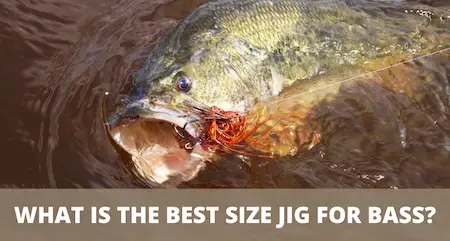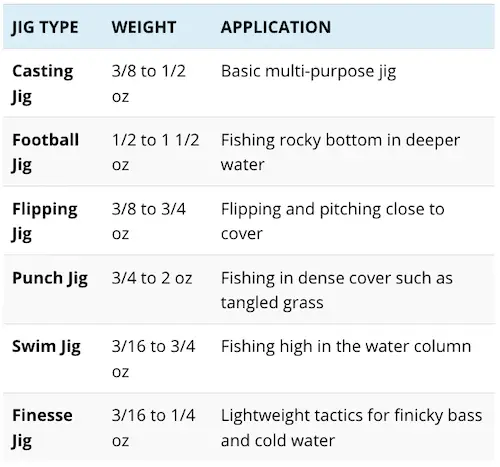What Size Jig Head To Use
What Is The Best Size Jig For Bass? (Complete Guide)
UPDATED 31 JULY 2022
past Robert Ceran
Jigs are among the almost effective and versatile bass lures available today, and produce more fish than virtually whatsoever other bait.
The only trouble is that they come up in a bewildering variety of shapes and sizes, each of which is designed to perform best in different weather condition.
So in social club to get the best results when jig fishing for bass, it'due south essential to understand non only what type of jig you lot should exist using in what situation, but also what size.

In this article we'll get over the most of import bass jigs, and discuss what sizes y'all should choose for each of them.
What size jig should yous apply for bass?
The best all effectually size for bass jigs is 3/8 to 1/2 oz. But if you're angling in deep h2o, or in heavy cover, you tin can increase the size up to 2 oz, and if you're throwing a finesse jig, you can reduce the weight down to 3/16 oz.
Different types of bass jigs are designed for dissimilar situations, ranging from open up water to thick cover, and from 3 anxiety of water to fifty pes deep h2o.
And obviously the best size to use depends on the conditions you programme to fish in.
So in this article we'll cover the 6 nearly important types of bass jigs, and discuss what sizes perform best for each of them.
Bass jig size chart
| JIG TYPE | WEIGHT | APPLICATION |
|---|---|---|
| Casting Jig | iii/viii to 1/2 oz | Basic multi-purpose jig |
| Football Jig | 1/2 to one 1/ii oz | Angling rocky bottom in deeper water |
| Flipping Jig | 3/8 to three/four oz | Flipping and pitching shut to cover |
| Punch Jig | three/4 to ii oz | Fishing in dense cover such as tangled grass |
| Swim Jig | iii/16 to 3/four oz | Angling high in the h2o column |
| Finesse Jig | three/16 to i/4 oz | Lightweight tactics for finicky bass and cold water |
The jig weight size chart higher up shows the recommended weights for the nigh important types of bass jigs, besides every bit the line-fishing application for which they are best suited.
At present let'south look at each of these jigs more than closely, to get a ameliorate understanding of what weight you should apply for each of them.
Casting jig: designed as a basic multi-purpose jig that tin work well for many standard applications. Its most characteristic feature is the apartment lesser jig head, which allows it to rest on the bottom with the tail sticking upward.
Sizes range from 3/viii to i/ii oz, and this is the all-time all around size range to use for most standard jigging applications.
Football jig: designed for fishing for offshore bass on rocky bottom in deeper h2o between 10 and l feet deep. The size range is from 1/ii to 1 1/ii oz.
Choose the weight according to the depth you lot want to fish in – the deeper the h2o, the heavier it should be. Also, the more wind and electric current you encounter, the heavier your jig should be.
Flipping jig: designed for making curt casts by flipping or pitching close to dense cover. The size range is from 3/eight to 3/four oz.
Cull the weight according to how thick the cover is that you lot need to penetrate, and also according to the fall rate you lot need to achieve. Since the autumn rate is critical for this technique, you should also examination different trailers to dial it in perfectly.
Punch jig (grass jig): designed with an oversized atomic number 82 or tungsten head to penetrate the densest vegetation, including tangled grass beds and laydowns.
The size range is from 3/4 to 2 oz, and depends on how thick the cover is that you need it to break through. It comes with a thick weed baby-sit that is sometimes doubled to protect it from getting snagged, making it the perfect choice for fishing heavy comprehend.
Swim jig: designed to be fished higher in the water cavalcade than other jigs (more like a spinnerbait or chatterbait). Its size ranges from 3/xvi to 3/iv oz, and should be chosen according to how high in the water column you want to fish it – the college, the lighter it should be.
You can besides use it to fish dense areas of submerged grass, in which case it's improve to cull a heavier jig to penetrate the dumbo vegetation.
Finesse jig: every bit the name suggests, designed for lightweight line-fishing tactics. A peachy choice for choosy bass, and also works well when the h2o is cold, equally the bass become more sluggish, and wearisome lure retrieval works better.
The size range is from 3/sixteen to ane/4 oz. Cull the weight according to the h2o depth, and how slow you want to brand your retrieve – the lighter, the slower you lot tin fish it.
All-time all around jig sizes for bass
The best all around jig sizes for bass range from three/viii to 1/two oz. These sizes are right in the center of the range, and work well for many different scenarios.
And so if you're new to bass fishing, or fishing a new lake or river for the first time, it's all-time to start with these sizes. Then, if y'all don't get a lot of bites, experiment with upsizing or downsizing your jigs according to the weather condition yous're angling in.
Jig weight and water depth
As you might expect, heavier jigs are better for fishing deep water, since they sink faster to the bottom, and information technology's easier to keep them on the bottom during retrieval.
That'south why football jigs are often on the heavier side, since they are intended to exist fished in deeper offshore areas of lakes.
On the other hand, if you're fishing in shallow water with no cover, a lighter jig is often a improve option, since it allows you to ho-hum down the retrieve charge per unit, and to continue your lure longer in the strike zone.
Consequence of jig size on fall rate
Some other factor to consider is the fall rate of your jig (which refers to how apace it falls to the bottom subsequently you pull it up with your rod).
A jig with a heavy head falls more than quickly than a low-cal one, and this is an important factor considering bass usually seize with teeth your lure while it's falling, and then yous'll want to choose the ideal fall rate for triggering the almost bites.
Depending on the state of affairs you're angling in, information technology can exist better to aim for a slower or faster fall rate. When bass are feeding aggressively, it'due south generally best to use the heaviest jig you can get away with, as that allows you to piece of work the jig faster, and cover more water.
On the other mitt, if the bass are finicky, it's ofttimes better to ho-hum things downward, and to use a lighter jig, or even switch to a finesse jig.
Keep in listen that another way to adjust the fall rate is by using a bigger, bulkier trailer that generates more resistance in the water. That fashion you can sometimes work with a heavier jig, simply nevertheless get a tiresome enough fall rate to trigger bites.
Choosing the correct size jig for heavy encompass
Some of the best bass angling spots during the summer are right in the centre of dense encompass, such equally lily pads, grass beds, or thick growths of water weeds that accomplish all the fashion to the water surface, forming what many bass anglers affectionately call "the slop."
If you want to accept a chance of penetrating this kind of dumbo vegetation with your jig, and of getting information technology to fall downwards into the h2o betwixt the plants, you need to use larger jig sizes, from 3/iv oz all the way up to 2 oz.
All-time jig size for finicky bass
When the bass seize with teeth is wearisome, or if you observe that they're only swiping at the trailer of your jig without eating it properly, it tin can exist very constructive to switch to a smaller, lighter jig, ranging from 3/16 oz to ane/4 oz.
There are two reasons for this: you can tiresome downwardly the retrieve rate with a smaller jig, and it besides has a slower autumn rate in the water. That gives finicky bass more time to commit to eating information technology, resulting in more bites.
This as well applies when h2o temperatures driblet below 60 to 65 degrees, as bass become more sluggish in cold water, and will non chase a fast lure.
If you're currently in the market for a bass jig rod, cheque out our article on what is the all-time bass jig rod?
Jig size nautical chart

What Size Jig Head To Use,
Source: https://sportfishingbuddy.com/what-size-jig-for-bass/
Posted by: davisonated.blogspot.com


0 Response to "What Size Jig Head To Use"
Post a Comment